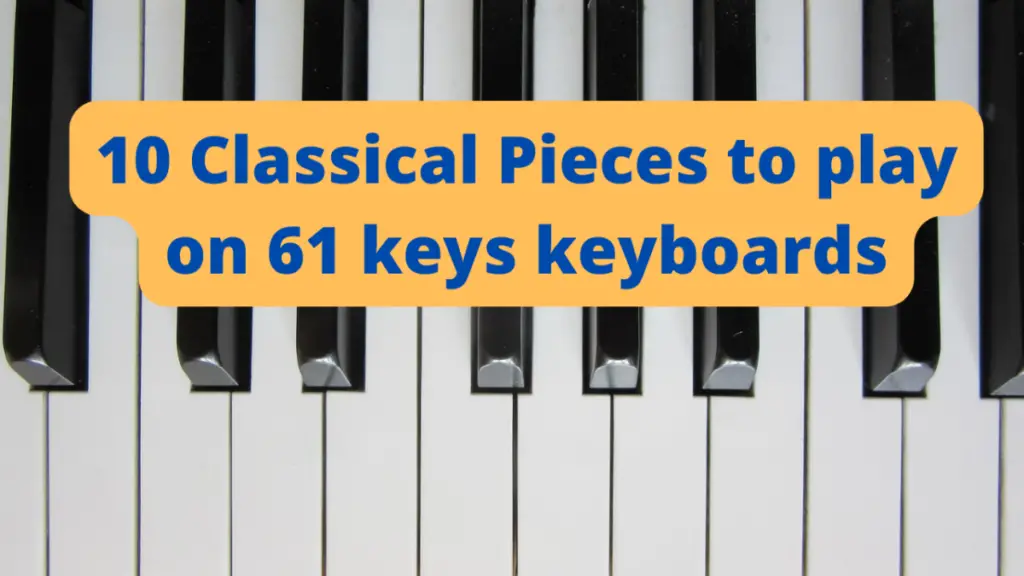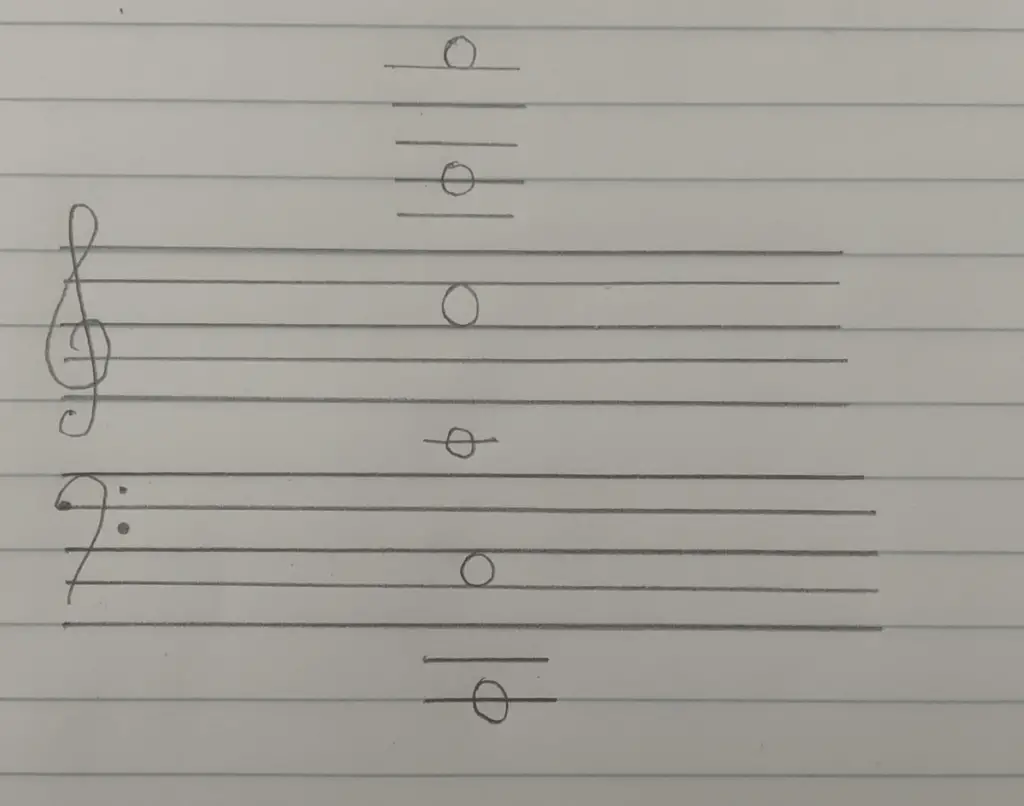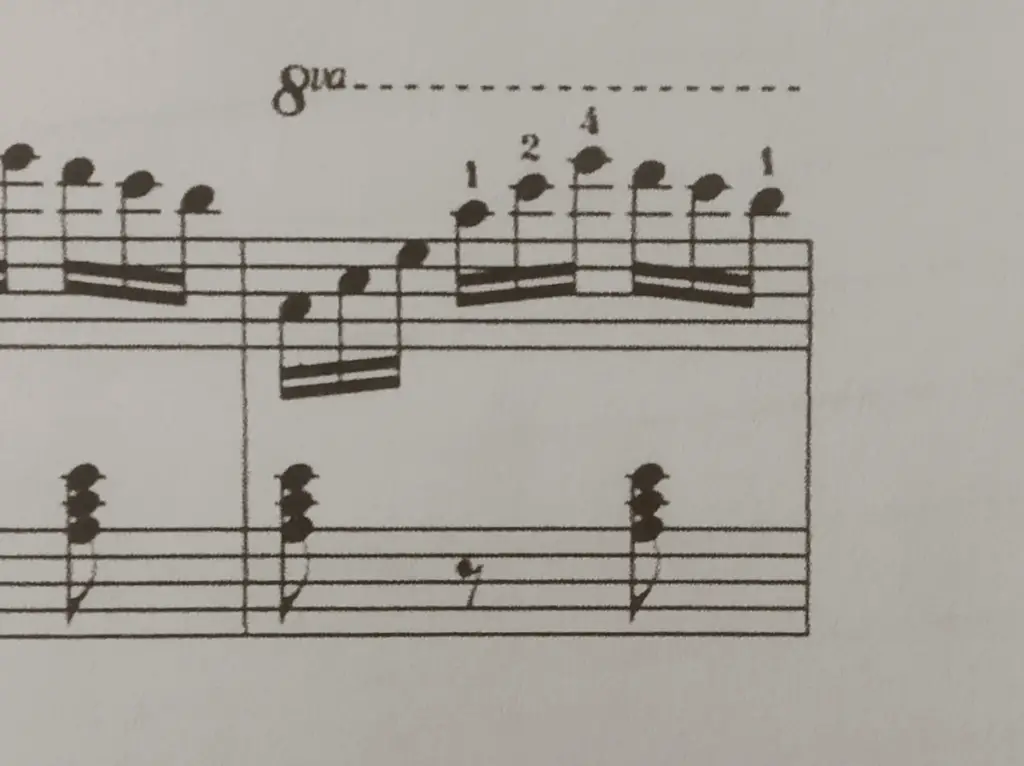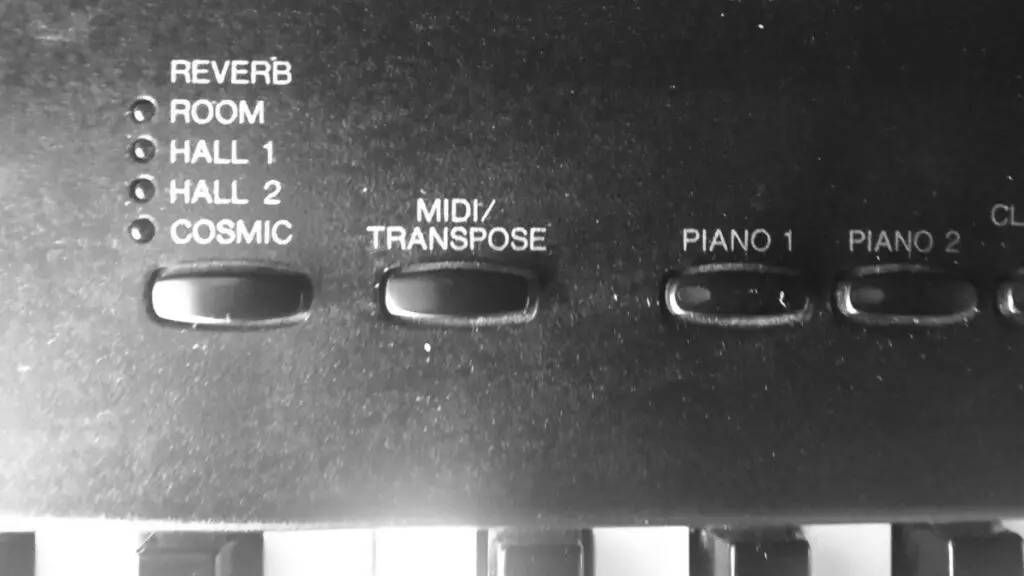This post contains affiliate links.

You love to listen to classical pieces from your favourite composers like Chopin, Mozart, Liszt or Debussy and want to play them on the piano. However, due to your budget, you can only afford to get a 61 keys keyboard. So you wonder if you can play classical piano pieces on a 61 keys keyboard. The answer is yes!
Here are 10 full-length classical piano pieces to play on a 61 keys keyboard:
- Prelude in C Major – J.S Bach
- Canon in D – Pachelbel
- To a Wild Rose – Edward Macdowell
- The Goldberg Variations – J.S Bach
- Sonatina in G major, Anh. 5, No. 1 – Beethoven
- Sonatina in F major, Anh. 5, No. 2 – Beethoven
- Piano Sonata in C Major, No. 16, K545 – Mozart
- Fugue Op. 87, No. 7 in A Major – Shostakovich
- Waltz in B minor, Op. 18, No. 6 – Schubert
- French Suites, No. 3 in B minor – J.S Bach
In this article, I’ll go through some famous composers with full-length pieces that you can play on a 61 keys keyboard since nothing is more annoying than being restricted to playing only a particular section of the piece due to the keyboard’s range.
I’ll also talk about the highest and lowest notes on a 61 keys keyboard so that you can find other classical pieces that fit into the 61-keys range.
I’ll talk about the “transpose” function that many piano keyboards have and how you can use that function to play the missing notes or sections of a piece that don’t fit in the 61-keys range.
I’ll also give some tips for playing some of these pieces since I’ve learnt to play them myself, and recordings of the pieces so you can choose the ones you like so you can learn how to play them on the piano.
Which classical composers can you play on a 61-keys keyboard?
You can play most keyboard pieces from the Baroque period (1600 – 1750) to the early Classical period (1750-1830), meaning you can play pieces from Bach, Mozart and Beethoven’s early works.
This is because the first piano wasn’t invented until the 1700s. Back then, the more popular keyboard instruments were the organ or the clavichord and there were only 5 octaves ( 61 keys) on the keyboard at the time. Furthermore, the 5 octaves on the keyboard of that time didn’t start from C to C, but from F to F.
Thus, composers of that period like Bach, Mozart and Beethoven wrote many keyboard pieces using 5 octaves. Nowadays, you can find transcriptions of these keyboard pieces to the modern piano that you can learn to play.
However, you won’t be able to play most pieces from composers like Chopin, Liszt or Debussy on a 61 keys keyboard because, by the time they were alive (19th century onwards), the modern piano with 7 octaves or more was already invented, and these composers usually used the whole 88 keys range when composing piano pieces.
Highest and lowest notes in a piece for a 61-keys keyboard
A 61-keys keyboard starts from C and ends on a C. Here’s what the range looks like on a grand staff on music sheets:


This means if you want to play full-length pieces on a 61-keys keyboard, you’ll need to find pieces that fit into this C to C range.
However, if you love a particular piano piece and don’t mind only playing a section of the piece due to keyboard range limitations, go for it! Some classical pieces only have a couple of notes out of bound so you can play the rest of the piece on a 61-keys keyboard.
For example, you can play most of Fur Elise by Beethoven on a 61-keys keyboard except for the last section at measure 79 where you have to play the notes written an octave higher, pushing them out of range of a 61-keys keyboard.
If you want to play Fur Elise on 61 keys, I talk about a modified version of Fur Elise that omit some notes so it can fit in 61 keys while still sounding more or less the same as the original: Can Fur Elise be Played on a 61-Keys Keyboard?

With that said, you may not need to compromise and only play a section of a classical piece. You can use the transpose button that many 61-keys keyboards have to make up for those missing notes.
Transposing the keyboard to play classical pieces on 61 keys
The transpose function allows the keyboard to shift one octave up or down when you press the button. Some keyboards can transpose multiple octaves. This means you can use this button to play the notes higher or lower than the default range of 61 keys.
But is it possible to use transpose function mid-performance? It’s possible if your transpose button is easy to use and for the part where transposing is necessary, your left hand only needs to play a couple of chords that can be sustained so you can quickly hit the transpose button and continue.
Take the example of Fur Elise again, in measure 79 and the previous measure 78, your left hand only needs to play 1 chord that you can sustain so your left hand is free to quickly hit the transpose button to shift an octave up so your right hand can play those higher notes.
However, for harder and more complicated pieces, or if your transpose button is hard to use, it’s impractical to transpose mid-performance.
Each keyboard has a different way to set up and use the transpose button, it can be a combination of pressing the transpose button itself and a particular key on the keyboard. Check the user manual for instructions and if you lost it, you can find a PDF version of it online.

List of full-length classical piano pieces you can play on a 61-keys keyboard
Prelude in C Major, BWV 846 – J.S Bach
A beautiful and simple piece from Bach, where the whole piece consists of broken chords, with each chord repeating once in each measure.
This piece is great for a complete beginner because the rhythm is easy and repeats throughout the whole piece, in 4/4 time signature with the quickest notes being eighth notes. You step on the sustain pedal every time you’re in a new measure.
This is the first piece I learned when I first started learning the piano, the hardest part is switching hands when I’m in a new measure since the tempo is so quick at 108. So definitely play this piece at a slower tempo 70-80 at first to be consistent, avoiding the problem of speeding up and then suddenly slowing down mid-performance.
Once you’re comfortable at a slow tempo, then you can play it at the tempo the piece suggests. Remember that if you can play a piece slowly, you can play that piece quickly.
Also, to cut down practice time in half, notice that the broken chords repeat once in every measure. So for each measure, skip that repeating broken chord and practice the transition to a new broken chord in the next measure more since that part is harder to memorize and get right.
I wrote more on the easy and hard aspects of this piece, whether you’re ready to play it and its piano grade in the article Is Prelude in C Major Easy? (and tips for learning the piece)
Canon in D – Pachelbel
Another famous piece that no doubt you have heard of before, even if you don’t know the name of the piece. A very popular piece to play during wedding ceremonies, and its chord progression is used in many pop songs nowadays.
To a Wild Rose – Edward Macdowell
American compose Edward MacDowell’s most well-known and beloved piece, “To A Wild Rose” was written in 1896 for solo piano and is a part of the suite Woodland Sketches which contains 9 other short piano pieces.
The piece was written in the key of A Major. You can try increasing the tempo to see if you like it better. I prefer playing it a bit faster.
The Goldberg Variations – J.S Bach
The Goldberg Variations was published in 1741 and consists of one Aria and 30 different variations. The name “Goldberg” most likely came from Johann Gottlieb Golberg, who was amongst the first people to perform the work.
One of my favourites from Bach. I enjoy and recommend you listen to Glenn Gould’s interpretation of it.
Sonatina in G Major, Anh.5, No.1 – Beethoven
Published in Hamburg, Germany after Beethoven’s death. It consists of 2 movements, with the first written in 4/4 time signature, and the second movement written in 6/8 time signature
1st Movement (Moderato)
2nd Movement (Romance)
Sonatina in F Major, Anh.5, No. 2 – Beethoven
The composition was written for solo piano with two movements in 2/4 time signature. Most of the first movement consists of sixteenth notes while most of the second consist of eighth notes.
1st Movement (Allegro assai)
2nd Movement (Rondo: Allegro)
Piano Sonata in C Major, No. 16, K545 – Mozart
Sonata in C Major is a well-known composition that was described by Mozart to be “for beginners”. The composition consists of 3 movements, and take 11 minutes in total to play.
1st Movement (Allegro)
2nd Movement (Andante)
3rd Movement (Rondo: Allegretto)
Fugue Op.87, No. 7 in A Major – Shostakovich
One of the 24 pieces of the “24 Preludes and Fugues, Op.87” by Russian composer Dmitri Shostakovich.
Waltz in B minor, Op. 18, No. 6 – Schubert
French Suites, No. 3 in B minor – J.S Bach
One of the 6 suites that Bach wrote for the clavichord or harpsichord originally. This No. 3 suite was most likely written in 1722

